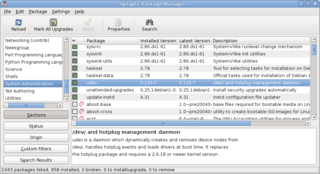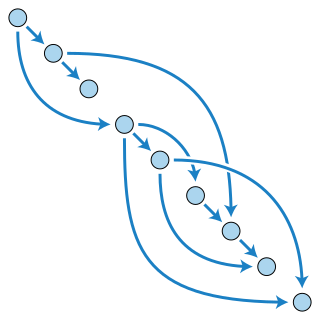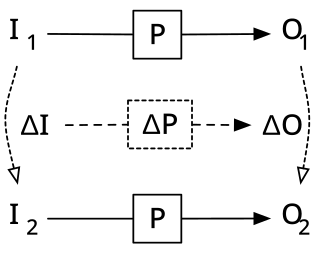In object-oriented programming, a class is an extensible program-code-template for creating objects, providing initial values for state and implementations of behavior. In many languages, the class name is used as the name for the class, the name for the default constructor of the class, and as the type of objects generated by instantiating the class; these distinct concepts are easily conflated.

A package manager or package-management system is a collection of software tools that automates the process of installing, upgrading, configuring, and removing computer programs for a computer's operating system in a consistent manner.
In software development, Make is a build automation tool that automatically builds executable programs and libraries from source code by reading files called Makefiles which specify how to derive the target program. Though integrated development environments and language-specific compiler features can also be used to manage a build process, Make remains widely used, especially in Unix and Unix-like operating systems.

In mathematics, particularly graph theory, and computer science, a directed acyclic graph is a finite directed graph with no directed cycles. That is, it consists of finitely many vertices and edges, with each edge directed from one vertex to another, such that there is no way to start at any vertex v and follow a consistently-directed sequence of edges that eventually loops back to v again. Equivalently, a DAG is a directed graph that has a topological ordering, a sequence of the vertices such that every edge is directed from earlier to later in the sequence.

Graphviz is a package of open-source tools initiated by AT&T Labs Research for drawing graphs specified in DOT language scripts. It also provides libraries for software applications to use the tools. Graphviz is free software licensed under the Eclipse Public License.
Dependency hell is a colloquial term for the frustration of some software users who have installed software packages which have dependencies on specific versions of other software packages.
Modular programming is a software design technique that emphasizes separating the functionality of a program into independent, interchangeable modules, such that each contains everything necessary to execute only one aspect of the desired functionality.
In software engineering, dependency injection is a technique whereby one object supplies the dependencies of another object. A "dependency" is an object that can be used, for example as a service. Instead of a client specifying which service it will use, something tells the client what service to use. The "injection" refers to the passing of a dependency into the object that would use it. The service is made part of the client's state. Passing the service to the client, rather than allowing a client to build or find the service, is the fundamental requirement of the pattern.
In software engineering, inversion of control (IoC) is a programming principle. IoC inverts the flow of control as compared to traditional control flow. In IoC, custom-written portions of a computer program receive the flow of control from a generic framework. A software architecture with this design inverts control as compared to traditional procedural programming: in traditional programming, the custom code that expresses the purpose of the program calls into reusable libraries to take care of generic tasks, but with inversion of control, it is the framework that calls into the custom, or task-specific, code.
In software engineering, a circular dependency is a relation between two or more modules which either directly or indirectly depend on each other to function properly. Such modules are also known as mutually recursive.
In object-oriented design, the dependency inversion principle is a specific form of decoupling software modules. When following this principle, the conventional dependency relationships established from high-level, policy-setting modules to low-level, dependency modules are reversed, thus rendering high-level modules independent of the low-level module implementation details. The principle states:

A package diagram in the Unified Modeling Language depicts the dependencies between the packages that make up a model.
This glossary of Unified Modeling Language terms covers all versions of UML. Individual entries will point out any distinctions that exist between versions.
In mathematics, computer science and digital electronics, a dependency graph is a directed graph representing dependencies of several objects towards each other. It is possible to derive an evaluation order or the absence of an evaluation order that respects the given dependencies from the dependency graph.
Object-oriented design is the process of planning a system of interacting objects for the purpose of solving a software problem. It is one approach to software design.
The tsort program is a command line utility on Unix-like platforms, that performs a topological sort on its input. As of 2017, it is part of the POSIX.1 standard.
In computing, reactive programming is a declarative programming paradigm concerned with data streams and the propagation of change. With this paradigm it is possible to express static or dynamic data streams with ease, and also communicate that an inferred dependency within the associated execution model exists, which facilitates the automatic propagation of the changed data flow.

Incremental computing, also known as incremental computation, is a software feature which, whenever a piece of data changes, attempts to save time by only recomputing those outputs which depend on the changed data. When incremental computing is successful, it can be significantly faster than computing new outputs naively. For example, a spreadsheet software package might use incremental computation in its recalculation feature, to update only those cells containing formulas which depend on the changed cells.
UML state machine, also known as UML statechart, is a significantly enhanced realization of the mathematical concept of a finite automaton in computer science applications as expressed in the Unified Modeling Language (UML) notation.
In computer programming, package principles are a way of organizing classes in larger systems to make them more organized and manageable. They aid in understanding which classes should go into which packages and how these packages should relate with one another. Package principles also includes software package metrics, which help to quantify the dependency structure, giving different and/or more precise insights into the overall structure of classes and packages.





